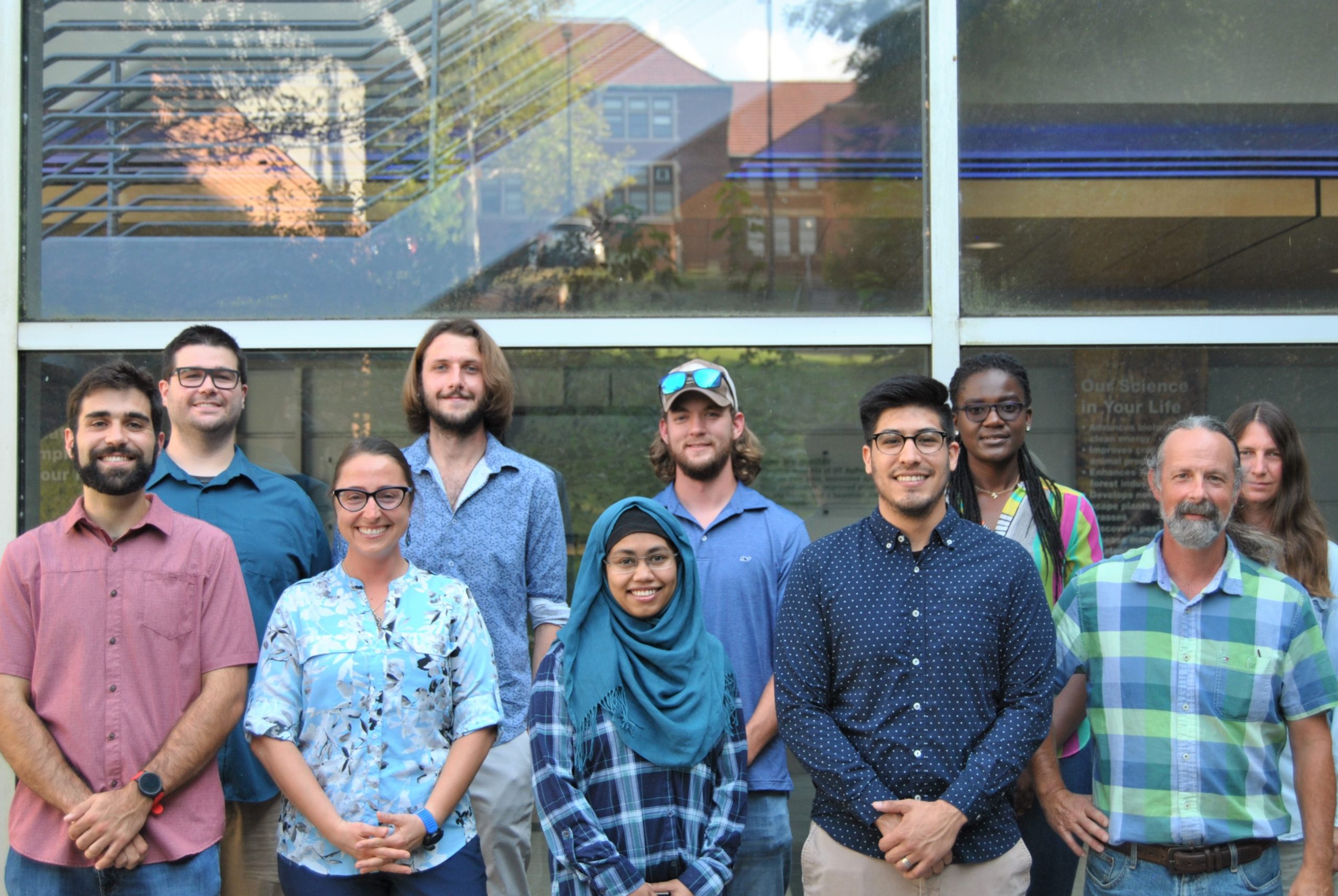My research focuses on population genetics of fungal plant pathogens, population biology, forest health, forest pathology, and diversity and conservation efforts of native plants. Our lab is interested in understanding complexity of host-pathogen-vector interactions and its associated microbial communities within the phytobiome across both introduced and native ranges. Increases in both native and introduced pathogens as a result of climate change have provided numerous opportunities in basic and applied research. My program’s main goal is to utilize novel genetic and genomic tools to integrate molecular data into pragmatic management decisions and provide solutions for preservation of biodiversity, conservation of native species and overall tree improvement programs. In addition, my research goal is to contribute to hunger eradication efforts on the African continent by preserving biodiversity of indigenous and nutritional plants adapted to climate change. This will not only provide regional food security, but will promote science literacy, and recruit and educate the next generation of science ambassadors in sub-Saharan African countries.
Overview
Research Projects
Host-Pathogen-Vector Interactions
My primary research centers on understanding host-pathogen-vector interactions with a focus on Thousand Cankers Disease (TCD) complex. The fungus, Geosmithia morbida, vectored by the walnut twig beetle, Pityophthorus juglandis, has been associated with disease outbreaks in walnut trees, Juglans spp., known as TCD. Read More
Phytobiomes of Trees
The complexity of host genetics and its associated microbial communities within the phytobiome (plant itself + environment + micro- and macro-organisms living in, on, or around the host plant) can vary across a plant’s introduced and native ranges, resulting in higher ecosystem multifunctionality and functional redundancy. Host phytobiome plays an important role in host plant defenses, nutrient acquisition, and stress tolerance, serving critical functions in the interaction between plants and the environment. Using walnut trees as a non-model system, we are evaluating the impact of the complex disease system, Thousand Cankers Disease (TCD), on host genetic diversity and examining the correlation between phytobiome and disease severity in both introduced and native ranges.
Conservation Genetics and Biodiversity
An additional component of my research program focuses on conservation efforts of native trees, preservation of biodiversity in North American forests, and overall forest and tree health and protection on a global scale. We intend to devote research and teaching efforts to limit the impact of forest diseases and provide an understanding of the evolutionary dynamics, diversity and disease ecology of environmentally, socially and economically, significant trees. Read More
Population Genetics
In my lab, we have a number of projects related to population biology/genetics of native and/or economically important plants, as well their pathogens. We are interested in a number of different factors including, but not limited to, understanding the basic biology of the host-pathogen interactions, host-pathogen coevolution, how spatial distribution influences genetic diversity, their population structure and patterns of gene flow. Using these tools can expand our understanding of the ecological and evolutionary dynamics and elucidate historical processes that are a result of the past or current disease outbreak(s).

Outreach
“Tell me and I forget. Teach me and I remember. Involve me and I learn.” The best way to share your passion is to teach and educate others. That is why I am involved in STEM outreach for both high school and college students. An undergraduate research opportunity I was given as a student was the sole reason I continued my scientific exploration through further education. As a result, I became the person I am today – someone who loves science and loves sharing that passion, enthusiasm and inspiration with students, through both research and teaching. I am a firm believer that the best way to learn is to teach and that one’s education is never ending.

Teaching
I strongly believe that a teacher is a role model, advisor, guide, inspiration, and someone who is fundamentally involved and entirely dedicated to their student’s success. A teacher leads by example, motivates and encourages students to be the best they can be, and to go beyond their limits and even their own expectations. I feel fortunate and humble that I am able to do a job where I can share my passion and enthusiasm while fostering the educational growth of students. Teaching is an incredible gift, but also an enormous responsibility. As a teacher and researcher, I would like to have the same impact on students that my teachers and role models have had on me. I would like to be the change and inspiration to improve the world we live in by supporting future generations of environmental stewards and scientists.
Courses
EPP 411 – Forest Insects and Diseases (3 credits)
EPP 531 – Special Problems in Entomology, Nematology, and Plant Pathology – Population Genetics (3 credits)
EPP 604 – Genomics of Forest Pest and Pathogens (3 credits; Co-teaching special topics class with Dr. Meg Staton)
EPP 604 – PopGen Journal Club (1 credit; Co-teaching special topics class with Dr. DeWayne Shoemaker)
Denita Hadziabdic Guerry
Associate Professor
Fulbright Scholar to Ghana (2018-2019)
Fulbright U.S. Scholar Alumni Ambassador (2022-2024)
Main Office (865) 974-7135
Fax (865) 974-4744
Email dhadziab@utk.edu
Lab Website https://hadziabdiclab.utk.edu/
349 Plant Biotechnology Building
2505 EJ Chapman Drive
Knoxville, TN 37996-4560
EDUCATION
B.S., Agriculture-Horticulture, Tennessee Tech University
M.S., Plant Pathology & Entomology, University of Tennessee
Ph.D., Plants, Soils & Insects (Population Genetics), University of Tennessee
PROFESSIONAL APPOINTMENT
80% Research, 10% Teaching,
10% Smith Global Leadership Fellow
GRADUATE PROGRAM CONCENTRATIONS
Bioinformatics, Genomics, and Molecular Interactions
Organismal Biology, Ecology, and Systematics
AREAS OF EXPERTISE
Forest health and forest pathology, population genetics of fungal pathogens, population biology, genetic diversity and conservation of native plants, molecular detection of pest and pathogens, phytobiome (plant host, their environment, and associated communities of macro and microorganisms), food security
KEY WORDS
Population genetics and genomics, pathogen spread, diversity and spatial distribution, thousand cankers disease, Geosmithia spp., host-pathogen-vector interactions, phytobiome, molecular detection
INFORMATION FOR PROSPECTIVE STUDENTS AND POSTDOCTORAL RESEARCHERS
My passion is enabling current and future students to exceed expectations in STEM. Students and scholars seeking research or professional opportunities in my lab should contact me with their CV and statement of intent at my e-mail: dhadziab@utk.edu.

RESEARCH QUESTIONS IN OUR LABORATORY

CURRENT LAB MEMBERS
SELECTED PUBLICATIONS
Names of students and postdocs from the Hadziabdic lab are underlined.**M.S./Ph.D. committee member
- Henkhaus N, Busch W, Chen A, Colón-Carmona A, Cothran M, Diaz N, Dundore-Arias J, Gonzales M, Hadziabdic D, Hayes R, MacIntosh G, Na A, Nyamasoka-Magonziwa B, Pater D, Peritore-Galve F, Phelps-Durr T, Rouhier K, Sickler D, Starnes J, Tyler Q, Valdez-Ward E, Vega-Sánchez M, Walcott R, Ward J, Wyatt S, Zapata F, Zemenick A, Stern D (2022) Removing systemic barriers to equity, diversity, and inclusion: Report of the 2019 Plant Science Research Network workshop “Inclusivity in the Plant Sciences”. Plant Direct 6(8): e432. https://doi.org/10.1002/pld3.432
- Hadziabdic D, Hamelin R, Stewart J, Villari C (2022) Editorial: Forest pathology in changing climate. Frontiers in Forests and Global Change: Pests, Pathogens, and Invasions. Special Topic: Forest Pathology in Changing Climate 5:103203. https://doi.org/10.3389/ffgc.2022.1032035
- Amissah J, Hadziabdic D, Boggess S, Trigiano R (2022) Genetic diversity and population structure of the antimalarial plant Cryptolepis sanguinolenta in Ghana. Frontiers in Conservation Science 3: 1020981. https://doi.org/10.3389/fcosc.2022.1020981
- Pietsch G, Gazis R, Klingeman W, Huff M**, Staton M, Kolarik M, Hadziabdic D (2022) Characterization and microsatellite marker development for a common bark and ambrosia beetle associate, Geosmithia obscura. MicrobiologyOpen (11):e1286. https://doi.org/10.1002/mbo3.1286
- Onufrak A, Ony M, Odoi M, Dugger C, Pietsch G, Phillips E, Grant J, Klingeman W, Hadziabdic D (2022) First report of Diplodia corticola causing dieback of white oak (Quercus alba) in Tennessee. Plant Disease. https://doi.org/10.1094/PDIS-02-22-0447-PDN
- Dominguez-McLaughlin H, D, Lawton C, Hadziabdic D, Boggess S, Ony M, Trigiano R (2022) A genetic analysis of grey squirrel (Sciurus carolinensis) populations in Ireland. Biological Invasions. https://doi.org/10.1007/s10530-022-02782-x
- Trigiano R, Boggess S, Odoi M, Hadziabdic D, Bernard E, Aime M (2022) First report of Coleosporium helianthi infecting Helianthus verticillatus (Whorled Sunflower) in the United States. Plant Disease 106(7): 1985. https://doi.org/10.1094/PDIS–11–21–2496–PDN
- Chahal K**, Gazis R, Klingeman W, Lambdin P, Grant J, Windham M, Hadziabdic D (2022) Differential virulence among Geosmithia morbida isolates collected across the U.S. occurrence range of Thousand Cankers Disease. Frontiers in Forests and Global Change: Pests, Pathogens and Invasions. Special Topic: Forest Pathology in Changing Climate 5:726388. https://doi.org/10.3389/ffgc.2022.726388
- Nowicki M1, Hadziabdic D1, Trigiano R1, Runge F, Thines M, Boggess S, Ristaino J, Spring O (2022) Microsatellite markers from Peronospora tabacina, the cause of blue mold of tobacco, reveal species origin, population structure, and high gene flow. Phytopathology 12(2): 422-434. https://doi.org/10.1094/PHYTO-03-21-0092-R; 1Equal author contributor with Nowicki and Trigiano.
- Hamm T**, Boggess S, Kandel J, Staton M, Huff M**, Hadziabdic D, Shoemaker D, Adamczyk Jr. J, Nowicki M, Trigiano R (2022) Development and characterization of 20 genomic SSR markers for ornamental cultivars of Weigela. Plants 11(11): 1444. https://doi.org/10.3390/plants11111444
- Sapkota S**, Boggess S, Trigiano R, Klingeman W, Hadziabdic D, Coyle D, Nowicki M (2022) Microsatellite loci reveal high genetic diversity, mutation, and migration rates as invasion drivers of Callery Pear (Pyrus calleryana) in the Southeastern United States. Frontiers in Genetics 13: 861398. https://doi.org/10.3389/fgene.2022.861398
- Eaton M, Beale J, Long S, Dreaden T, Blevins A, Buland M, Hadziabdic D, Crocker E (2022) First report of Laurel Wilt caused by Raffaelea lauricola on Northern Spicebush (Lindera benzoin) in Kentucky and Tennessee. Plant Disease (In Press).
- Wong W, Tung H, Nurul Fadhilah M, Midot F, Lau SYL, Melling L, Astari S, Hadziabdic D, Trigiano R, Goh Y, Goh K (2022) Evidence for high gene flow, nonrandom mating, and genetic bottlenecks of Ganoderma boninense infecting oil palm (Elaeis guineensis Jacq.) plantations in Malaysia and Indonesia. Mycologia 114(6): 947-963. https://doi.org/10.1080/00275514.2022.2118512
- Hadziabdic D, Onufrak A, Gazis R (2022) Fungi in forested ecosystems. In: Gall, I. and N. Benkeblia eds. Mycoagroecology: Integrating fungi into agroecological systems. CRC Press, Boca Raton, FL. pp. 175–195. https://doi.org/10.1201/9780429320415







